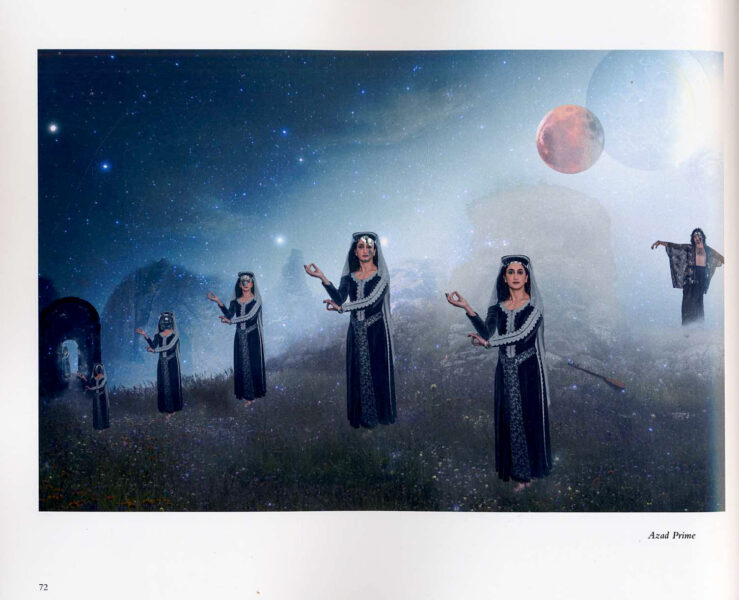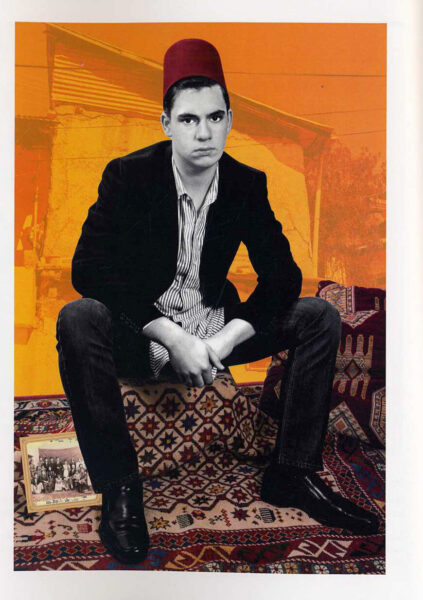While major upheavals such as the recent fall of Artsakh or the destruction of Gaza and the millions of persons displaced globally continue to threaten humankind, Kristin Anahit Cass offers the world images of peace and of solidarity. The artist’s Reparations of the Heart: Toward a SWANA Futurity (Fifth Wheel Press, 2024), an assembly of photographs, commentaries and short narratives inspired by her ancestors’ culture, debunks the myth that it is possible to annihilate a people and erase their ancient customs. In fact, by reappropriating the past Cass subverts the all-too-popular notion she has been brainstormed with her entire life as the offspring of Genocide survivors — that to survive their trauma the forcibly displaced need to assimilate themselves completely. The fictional world Cass creates suggests that reviving the ancestral home may in fact be the way for refugees to survive in alien lands.
The artist’s is a call for connection with our past. Her photographs are for the most part emblematic constructions bringing ancient culture into a modern space, with black and white portraying the past and color the present. The heirloom garments the characters wear in these compositions and the traditional foods they cook while they “assimilate” show that one can continue to embrace the culture even when one is far from the ancestral land. One portrait features her son Hrant as a young member of a wedding party of her family in Kharberd, creating a connection to roots, to who they are and where they came from. Another portrait foregrounds the “Healing Power of Za’atar,” the herb and spice mixture popular throughout Lebanon, Syria and other countries in the Mediterranean region. Whatever the theme of the different pieces, the objects and the relics displayed — the water jug and coffee set — inevitably evoke intimacy and closeness. It was with coffee — soorj — and coffee cup readings that these photographic sessions came together, jokes Cass: “We connected, we conversed, we collaborated.” What ultimately emerges is the sense of joy in being together.

When at the “meet the author” event at the Armenian Arts Center in Glendale, organized by ABRIL bookstore, the artist was asked why she chose the SWANA framework — acronym for South West Asia and North Africa, a decolonial term that refers to the geographical region also known as The Middle East and North Africa — to tell her story, “We need regional solidarity to counter the dirty game of empire,” responded Cass underscoring the shared historical trauma and the experience of diaspora of the peoples of the region. If we work together with “tenacious insistence” we can extend solidarity to other indigenous groups, she added with confidence.
Indeed, many of the individuals used to create the photographs are individuals of SWANA backgrounds — Jordanian, Assyrian, Lebanese and Palestinian diasporans. Nonetheless, it is through the celebration of the individual culture that the artist’s vision of a better future for all oppressed people is realized. “The Story of Azad Prime,” for example, tells the story of how technologically savvy Arevik helped lead her people, displaced and homeless in the diaspora, to Azad Prime, the place of freedom. Arevik is a genocide survivor. She is a refugee with no home to go back to. Yet she finds home before the invaders come, and brings her people to the place of “love and light” where they can live freely, in peace and in harmony.

It is not by pleading for mercy from the rulers that Cass creates this happy new world. The chance of liberation for those forcibly removed from their ancestral lands comes from “the mother who led us here,” the goddess Anahit who gave her people a sacred stone that would help them in times of trouble. The amulet passed from Anahit’s granddaughter Naira, to Astghik, to Arevik. Most fittingly, the book promotion event highlighted the centrality of this female lineage. Watching mother Anahit Cass and daughter Araxie Cass, a writer herself and the editor of the book, in discussion on stage about Anahit’s book evidenced the love and the support mother and daughter have for each other. Their joy was visible.

